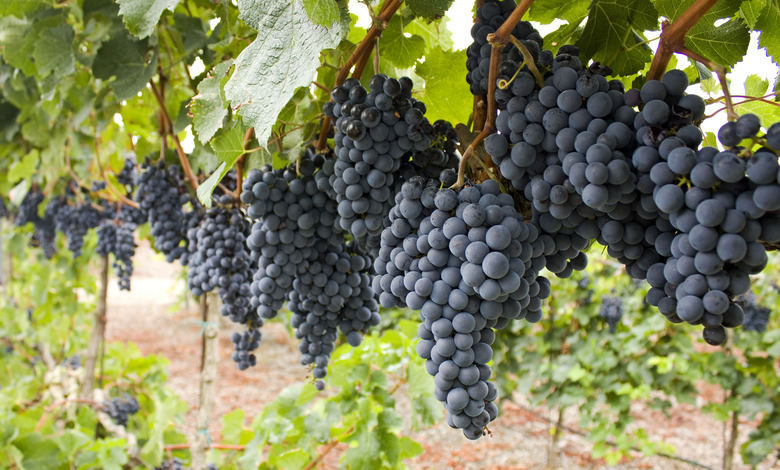Emilio Moro Of Spain's Ribera Del Duero Is A Producer Worth Knowing
Spain is the best producer of value wine around today. For less than $10, Spanish vintners can put a bottle of red wine on the American table that will be a worthy companion to the best steak, lamb, or game. The Spanish sparkling wine, cava, offers more interesting flavors and textural range than its Italian competitor, prosecco — for the same price. Spain makes white wines full of character, too, and in abundance, though Americans sometimes ignore them because many are made from indigenous varietals (albariño, godello, verdejo, viura, etc.) and less often from chardonnay or sauvignon blanc (which, together with pinot grigio, account for over 95 percent of varietal white wine consumption in the U.S.).
The value proposition runs through the whole price range of Spanish wine. Those classified "Gran Reserva" or otherwise labeled best in class are Spain's entries into that amorphous category "world class" and generally sell at well below the price of their French, Italian, and California counterparts.
At least in part due to the fact that they're generally great values, there are now more Spanish labels available to U.S. consumers than ever before — and the wines are better than ever.
With the array available, it pays to know your producer, of course. Recently, one came through town who embodies the best of the region he represents. José Moro, president of Bodegas Emilio Moro, located in Pesquera del Duero, is the third generation of the Moro family to run the winery (he does so with his brother Javier). Emilio Moro is located in the Ribera del Duero D.O., arguably Spain's second most famous wine region after Rioja. It is situated geographically in north-central Spain, a two-hour drive from Madrid. Politically, it is in the region of Castile and León. The dominant geographical feature is the river Duero, which flows through it and many other northern Spanish winemaking regions, and on into Portugal — where, as the Douro, it flows through the area used to grow grapes for port, then into the sea at Porto.
In the last 30 years, the Ribera del Duero region has distinguished itself oenologically by becoming synonymous with sophisticated and long-lived red wines built around the tempranillo grape (known locally as tinto fino). White wines are virtually non-existent; the bit that is made, usually from the indigenous albillo grape, is almost entirely consumed locally. The reds include both 100 percent tempranillos and red blends involving the Bordeaux varieties cabernet sauvignon and merlot, usually with some tempranillo added. Which is the better approach is a matter of taste, as one of the region's two top wines, Vega Sicilia, is a blend, and the other, Pesquera, is all tempranillo.
On this issue, Emilio Moro is decidedly in the monovarietal camp: All of its current offerings are 100-percent tempranillo.
Moro farms over 200 hectares (about 500 acres) of vines. They grow at altitudes of between about 2,500 and 3,000 feet. At the lowest point, near the river, the soil is granitic with some sand. The vineyard's soil contains progressively more clay as the slope rises, and the earth is calcareous at the top. Moro viticulturist Vincente Abete considers the grapes from the highest altitudes to be the best. The area is subject to large diurnal shifts of temperature, from 95 to 100 degrees Fahrenheit at the middle of the day during ripening to 45 to 50 degrees at night. Abete credits this for the development of the polyphenols that give the resulting wines their character.
Tempranillo grapes here look different from those in Rioja. They are smaller, with thicker skins. Due to the higher skin-to-juice ratio and the tannin levels in the thicker skins, the resulting wines are more concentrated and structured. Cultivation of the vines is somewhat different from conventional practice. Ninety percent of the vines are pruned in the ancient goblet style (unsupported by wires so the vines grow in a goblet shape), known as espaldera in the region. This enables easier harvesting but does not otherwise affect the quality of the grapes.
The aging regimen for the wines varies, from the basic Finca Resalso — a fresh, fruity wine meant for immediate consumption, accounting for half of the winery's output — which has only four months in French oak, to the Malleolus offerings, which see considerably more wood. The straight Malleolus, which costs around $40 a bottle, spends 18 months in French oak; the single-vineyard Malleolus de Valderramiro undergoes malolactic fermentation in American oak, then also spends 18 months in French oak; the winery's other single-vineyard wine, Malleolus de Sanchomartín, undergoes malolactic fermentation in French oak, then spends 18 months in the same wood. These two are considerably more expensive — about $125 and $140, respectively — but compare favorably to more expensive serious reds from other regions.
Both the Malleolus de Valderramiro and the Malleolus de Sanchomartín are intensely powerful wines, designed for long aging, and both regularly score at or near "classic" levels in all the major international wine publications.
When I tasted with José Moro recently at Pappas Bros. Steakhouse in Dallas, my first thought was how impressive the two single-vineyard wines were. We tasted the current release of both, the 2011 vintage. They seemed younger than their six years, and I thought they might last forever — though I'd sample them after a decade to gauge their progress. The quality of the 2016 Finca Resalso was also very good, and a bargain at its price of $15.
Emilio Moro wines are widely distributed and highly recommended.
Read more about the wines of the Ribera del Duero.
